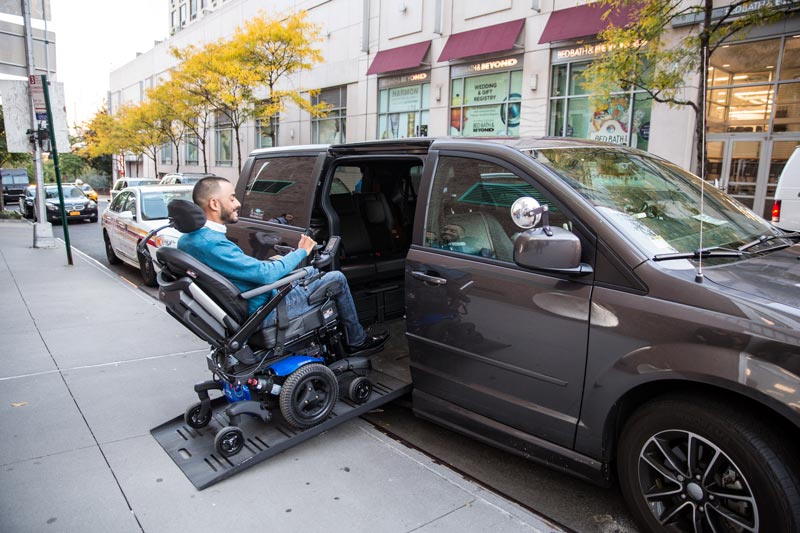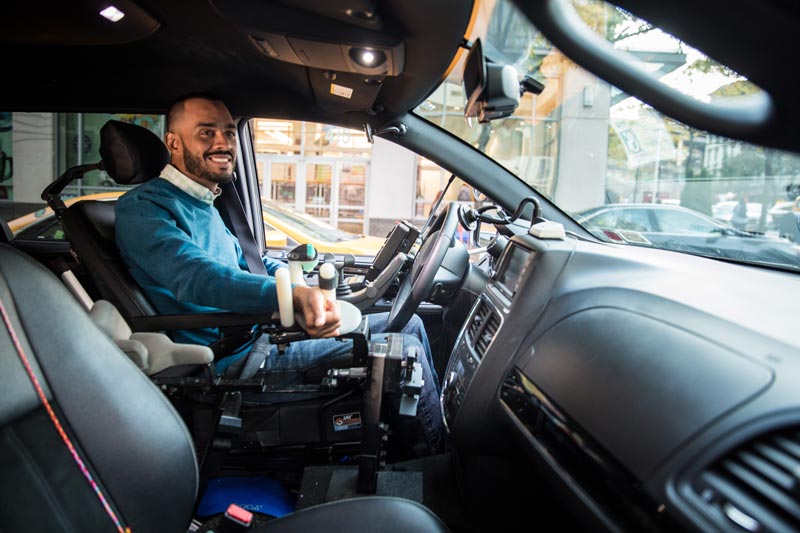My journey to becoming a driver with a disability began at a very young age when I watched my father drive his orange full-size van. I remember this detail so vividly because as a child, colors are the way you see the world; I was fascinated by the ability to place a key into this marvelous machine and command it to take you where you want to go. During the summers we would all jump into the van as a family, find our sitting position anywhere on the floor (as there usually weren't enough seats) and off we went! Anywhere from a few minutes to a few hours later we were at a fun, different location – sometimes familiar and sometimes new.

As I grew up, my fascination only continued to grow as our family vehicles changed over time. I watched my father work on our vehicles and modify them to his liking. Not only did he command this machine to take him where he wanted to go, but he also had the ability to make it look and feel the way he wanted it to. From the orange full-size van to the Pontiac Fiero and the Cutlass Supreme, my father had many vehicles while I was growing up. But there was one car in particular that I swore would be mine when I was an adult: the 1979 Toyota Corolla coupe.
My father's 1979 Toyota Corolla coupe had a wonderful stereo system and a bunch of exterior lights. It was just large enough for my father, mother, and the three of us sitting in the backseat. Despite its size, he did everything in that vehicle. We would go on weekend cruises to the beach while Spanish music played on the stereo. When the sun fell, the car would come to life. Blue lights on both the passenger and driver doors would vertically illuminate on each side of the car, complete with a white boomerang adorned with little red lights.
Fast-forward to June 19, 1995 when I suffered a tragic driving accent, shattering a vertebra in my neck. I was now a C-5 quadriplegic with no movement in my legs, very limited movement in my arms, and reliant on a motorized wheelchair for mobility. Driving was the furthest thing from my mind at that moment. Thankfully, I decided to finish high school and ultimately went on to obtain my bachelor's degree in Computer Science from St. John's University.
First Driving Lessons
I applied for vocational rehabilitation services when I decided to go to college and learned that my state's vocational rehab would pay for disabled driver training courses. So in the summer of 2000 I decided to apply and have my first driving experience. Vocational rehab paid to transport me two hours from my home in the Bronx to the training facility on Long Island. Going into this facility on Long Island, I had no idea what to expect. The first hour was spend measuring my strength and depth perception. They attach your hands to ropes, and the objective is to use the ropes to line up two objects in front of you – talk about low tech. Once you pass a preliminary test, you meet your instructor.
My instructor was a very odd man. I say that because it was the middle of July (probably a 90° F / 32° C day) and he was wearing a winter coat and boots. I couldn't help but ask why the unusual wardrobe, which I later found out was because he would frequently go in and out of air conditioning, causing him to get sick a lot.
He took me out into the parking lot, where I saw the first vehicle I was to drive: a big, blue, full-size van. Because it was one of their demo vehicles, it had several types of hand controls installed on it. The instructor proceeded to strap me down into the vehicle and explained to me that I would be using the electric gas and brake, and a small steering control called the DS 2000 (which was basically a circle with a tri-pin on it) all to the right side of my wheelchair. After going through the basic instruction on how to start the vehicle and getting the system calibrated, I heard the words that frightened me more than you would ever imagine: "Put it in drive." It terrified me because the last thing I would ever want to do, and this is true to this very day, is to hurt myself or anyone else.
After going around the parking lot twice, the instructor felt comfortable enough to tell me to go down the driveway and make a right. Let me explain: I was only basically driving for about an hour before he told me to actually start driving on the road! Even for me, the thought of a C-5 quadriplegic driving on public roads was outrageous... but this is what I was there for. Being on the road was the craziest feeling, and the most frightening, because you're controlling this powerful machine completely by electronic controls using your arms, and the slightest movement will make you accelerate or brake extremely hard.
Unfortunately I had to stop after only three lessons because I was feeling extremely guilty about leaving my mother, who was sick at the time, two hours away. I felt defeated, but I knew I did the right thing because my mother is a lot more important to me than driving. It would be a little over 10 years before I would get the opportunity to get my license again.
Back on the Road
After obtaining my bachelor's degree and riding a few emotional waves, I pulled myself out to a better place and landed my first job. I now made enough money to start saving with the hope of purchasing and maintaining my own vehicle. This is when I knew it was time for me to finally complete my dream of driving. After months of conflict with the New York State vocational services, I finally got approved to take driving lessons once again. This time, however, it would be with a different driving school located in Brooklyn.
Now I was learning on an older vehicle with completely different controls: a 1993 Ford Econoline 150 with an extended wheelbase, faded green paint, and one of the oldest wheelchair lifts that I have ever used. The Ford had a very old tan carpet, no steering wheel, a not-so-easily removable driver deat, and a control panel to the left side of the driver's side that looked like a rainbow of buttons. Although my first impressions were not very good, I would come to learn and enjoy the green machine.
This new-to-me driving system is called the "Scott Driving System," and it consists of a tri-pin that, when rotated to the left or right, would turn the vehicle's wheels in that corresponding direction. When pushed forward or back, it would actuate the gas and brake. Form the moment I understood the controls, driving this vehicle almost felt like second nature. I guess the instructor thought so too, because he immediately said to make a left into traffic. And not just any traffic – this road consisted of two lanes in both directions. So picture a total of four lanes with scores of vehicles parked on either side while I attempted to merge into traffic!
After two lessons, the instructor felt comfortable enough to continue doing business on his phone during our lessons while paying little attention to how I was driving. For me, the most difficult part about driving was parking. I didn't learn right away and even after I got my license, I needed practice. After taking a total of 10 lessons, I took the driving test and, I guess it was nerves, but I completely failed the driving test.
Committed to Success
I was extremely disappointed in myself. I didn't start this journey 10 or 11 years ago only to fail my first driving test. I was so hard on myself, but everyone told me that it's okay and most people fail their first test. Although this might be true, it didn't make me feel better. The instructor decided that I needed one or two more lessons to reinforce what I already knew, and he used this opportunity to ease my fears and calm my nerves. We scheduled my next driving test the very same day and I vowed I would be ready this time.
I got up that morning and it seemed like déjà vu, but I had a different focus this time. I kept telling myself, "You know this, you got this, and don't let the nerves get the best of you." Have you ever wanted something so badly that you psyched yourself out? Well, that's what happened to me the first time I went in there. I had a game plan and I thought that I knew what to expect, but as soon as that instructor gave me my first instructions, I choked. Not this time! We pulled up to the testing site and there was my nemesis, the instructor who failed me the first time. I was staring him down as if this was the rematch, but I was determined to win.
We lined up the vehicles in the order we arrived. I must have been the fifth vehicle on the list, and I slowly moved up in the line to get closer. As it neared my turn, the butterflies came. "Come on José, don't do this to yourself again. You got this," I said over and over. Now it was my turn, and I was ready for my rematch! I turned my head to the passenger side only to be surprised that I didn't have the same instructor. I didn't know if this was a good thing or a bad thing. However, this new instructor could only judge me on my current driving ability, not my previous failure.
Here we go! She sat down in the passenger seat and told me to start when I'm ready. I looked at my mirrors to ensure that they were in the proper position, I checked my seatbelt, I looked over at the instructor to ensure that she had her seatbelt on, I asked her if she's ready (yes). I started the vehicle (vroom), the instructor said to pull to the end of the block and make a left. This time the test went off without a problem, except for a little hiccup that even to this day I have when reversing: I tend to hit the brakes a little harder than I should, however this is due to the sensitivity of my hand controls. This time I passed, and I accomplished something that I wanted for so very long. I finally got my driver's license.

About the Author
José Hernandez is a C-5 quadriplegic due to a spinal cord injury sustained when he was 15 years old. After his injury he developed a passion for mentoring others with similar disabilities, including individuals in nursing homes and in rehabilitation centers. In 2011, José had the opportunity to go to Washington, D.C. as part of United Spinal's Roll on Capitol Hill annual event. This trip ignited an interest in advocacy, and he has been back to D.C. frequently as well as advocating on state and city issues. He is currently the NYC Advocacy Coordinator for United Spinal Association and the President of United Spinal's New York City chapter. In 2019, José was appointed by Mayor Bill DeBlasio to be a Commissioner of the NYC Civic Engagement Commission to ensure that the city includes individuals with disabilities in all aspects of civic engagement.
Most of the stories here on LiveQuickie.com were submitted by readers. Do you have a story to tell? We'd love to hear it. Submit your story here.